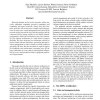571 search results - page 101 / 115 » Improving the Usable Capacity of Ad Hoc Networks |
OPODIS
2010
14 years 9 months ago
2010
Abstract. Wireless Ad-hoc networks are distributed systems that often reside in error-prone environments. Self-stabilization lets the system recover autonomously from an arbitrary ...
ICC
2009
IEEE
15 years 5 months ago
2009
IEEE
— In cellular networks, relays and/or mobiles can cooperate to improve the overall system performance. For example, once the transmission from a base station with multiple antenn...
102
click to vote
JSAC
2011
14 years 6 months ago
2011
Wireless vehicular ad hoc networks are characterized by multi-hop transmission, where a key problem is the design of routing, e.g., how to efficiently direct the information flo...
103
click to vote
AAAI
2004
15 years 13 days ago
2004
We will demonstrate the Secure Wireless Agent Testbed (SWAT), a unique facility developed at Drexel University to study integration, networking and information assurance for next-...
WICSA
2004
15 years 12 days ago
2004
Research domains such as active networks, ad-hoc networks, ubiquitous computing, pervasive computing, grid computing, and sensor networks, clearly show that computer networks will...

